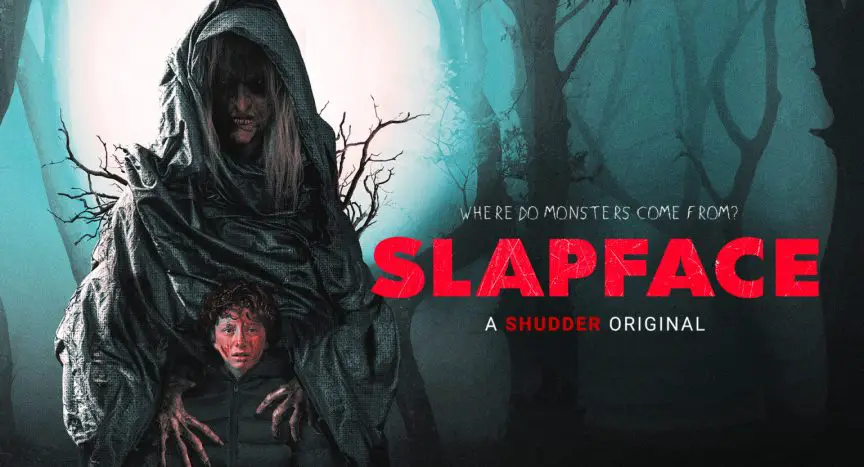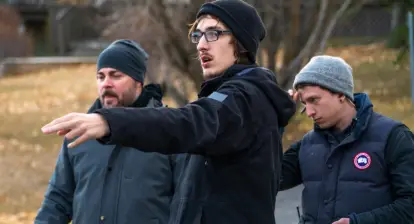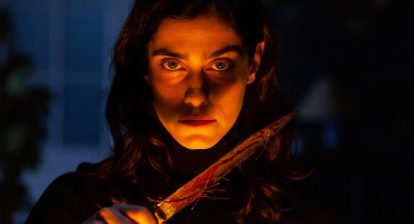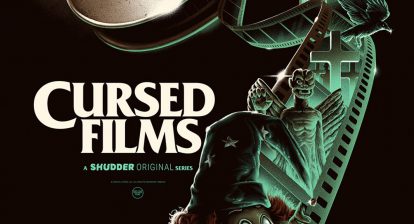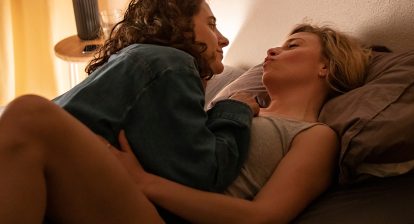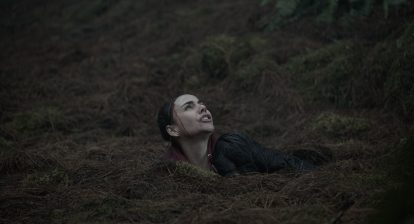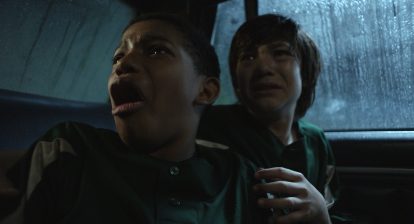The Shudder slate this month features originals like All the Moons, They Live in the Grey and Hellbender. Another notable addition is Jeremiah Kipp’s monster tale Slapface. Slapface stars August Maturo (The Nun), Mike Manning (Teen Wolf), Dan Hedaya (The Usual Suspects), Mirabelle Lee (Blood Ties), Lukas Hassel, Libe Barer (Sneaky Pete), Bianca D’Ambrosio (The Bay), and Chiara D’Ambrosio (I Am Mortal). The film follows Lucas, a loner who lives in a rundown home with his brother, Tom. He regularly seeks solace in the nearby woods. With his only “friends” being a group of female bullies, he keeps to himself most of the time. But, after a strange encounter with an inhuman monster, Lucas begins to withdraw from others. When the two reach a tentative trust, a bizarre friendship is born, and Lucas is swept up in a series of primal adventures. Adding to the chilling tale is the score by composer Barry J. Neely, whom recently took home the Grimmfest Film Festival “Best Score” award for his compositions. You can listen to the full score here. Check out our exchange with him, below.
Wicked Horror: What about the Slapface script made you want to work on the project?
Barry J. Neely: I usually don’t go by the script when I choose a project. Not even sure I was sent the script for Slapface! That’s probably because they already had a rough cut of the film by the time I was brought on.
Scripts give me a good idea of the story, but I want to hear about the intentions from the director. I want to know what the director FEELS about the characters and feels about the story, because that’s what I’m ultimately going to be writing music about, the characters.
WH: Can you talk about the opening credits. Some of the sounds are pretty piercing. What instruments did you use for these?
Barry J. Neely: Fantastic, “piercing” is what I was going for in some places. There’s an initial rumble, which I used for the quick transitions throughout the film, and that came from a kick drum I tuned really low, and used soft mallets to roll with. Then we hear the pure, but also “scrape-y” tone of a Tibetan singing bowl ringing over everything, and on top of that a really, super-slow melody played by two instruments: a 4-string “Appalachian” dulcimer that I also tuned low, distorted a bit, and bowed with a cello bow. And a santur, which is also part of the dulcimer family, but that you hit like a drum with these tiny, thin, wooden mallets. I had to dull that sound a bit because it was too “tinny”, and I did that by tying string around the mallet heads. And then you add the layer of violinist Crissy J playing her parts “off,” which was really my only note for her.
Let’s just say, everything in the intro is designed to make you feel uncomfortable.
WH: Do you look at the opening credits as setting the tone for the rest of the film’s sound?
Barry J. Neely: I always look at them as kind of an “overture”. But that’s only if there is a title sequence, of course. I’m big into keeping a consistent sound over the course of a film, so openings are the time to introduce those sounds, to get the audience familiar with what’s ahead.
There’s not a lot of information for the audience at the very beginning, so it’s partially my job to guide them to what’s about to come. Such responsibility!

WH: You have previously said that to prepare for the film, you dove into some horror soundtracks. What soundtracks specifically did you listen to?
Barry J. Neely: I listened to “The Witch” a bit at first. I love the broken-down, “raw” feel of the film and the soundtrack. And that’s a feel I wanted to do in Slapface: not a huge orchestra, nor anything “industrial” or “electronica” but more traditional, almost “folk” instruments. Also, producer and star Mike Manning really liked the music to Ozark and showed me some clips, so I listened to those as well.
But honestly, I only did a sampling of soundtracks, just some initial research. I knew the focus of the movie was going to be Lucas and trauma, so I just started writing for that.
WH: What scene came most natural for you to score?
Barry J. Neely: I started writing specifically to picture when Lucas went to the abandoned building for the second time. But that was me figuring things out, which sounds were working and which weren’t. So, the scene that felt the most natural was the police station scene where Lucas wakes up after being questioned by the Sheriff. And this was the second scene I scored. This was probably easier for me because I had my initial melodies worked out, I had the instruments I knew I wanted, and that scene was long, so I could really let things take their time. That’s always fun for me.
Five Extremely Impressive Feature Film Debuts

WH: When Lucas was first going through the abandoned building, it sounded like there was some sort of bell you were using. It repeats when he goes back. What was this and why did you decide to use it?
Barry J. Neely: That’s the Tibetan singing bowl I used in the intro. It’s pretty much a metal bowl you scrape around the rim with a wooden mallet. But let me admit, I probably didn’t play this very well! But that also worked to my advantage.
When I chose certain instruments for this film, I knew I would need sounds that could sustain themselves for a while. Too many shifts in instrumentation can be distracting. And a lot of the scenes were like this, where we want an underlying sound to support the creepiness, but too much would take us out of the scene. I used the Tibetan singing bowl in both “something’s about to happen” as well as any “calm” scenes with the Witch and Lucas. Because “calm” will always mean “unsettling” in this story.
Cool thing about this instrument is that the one note it produces is not really in tune, not on the one I had. When it’s used in busier scenes I would have other instruments play the same note, but in tune. Nothing about this score is suppose to sound harmonious.
WH: Tell us about your creative process. What do you do first when creating music for a project?
Barry J. Neely: I usually think “what have I not done musically that I want to do”? I’m a bit selfish, sorry. Of course, in the end, the film and the visuals are the center of any decision I make. But that doesn’t mean I don’t have other intentions!
Often I sit at the piano to develop an overall feel, an overall theme. And then I start extracting from that theme. I then think about how the instruments I have at my disposal can support that theme.
Did You Know? Wicked Horror TV Has Independent and Classic Horror Films Available for Free!
WH: In final scene of the film, who was the singer you incorporated into the score?
Barry J. Neely: I wrote most of this score during the beginning of the pandemic. So, I’m pretty lucky that my partner is a professional actor and singer. That’s Zehra Fazal. Her voice can be heard everywhere in animation, videos games, and she also can be seen on TV. But she’s ALSO a very talented and trained singer.
I wanted to give a “voice” to the Witch. Not an obvious one, not a “pretty” sounding one. I directed Zehra to almost sing “blank” and “neutral” with almost no character at all.
WH: Are you personally a horror fan? If so, what are some films that made a lasting impression on you?
Also See: Also See: Why Teen Horror is Still Relevant (Even if it’s Basically Disappeared)
Barry J. Neely: Horror has always been a part of my life. But I guess I never considered myself a horror fan. Maybe because I’ve seen true horror fans, and they know their stuff better than I ever will.
But “The Lost Boys” was a film I watched over and over. I watched “Creepshow” and “Creepshow 2” and I probably never, ever should have because now I have problems swimming in lakes! And “Tales from the Crypt” was always on for me. I’m still scarred by the “who’s holding the camera??” line from the episode where TV host Morton Downey, Jr goes into a murder house with his camera crew. Well, let’s just say that line still gave me chills even saying it now.
Special mention for “Maximum Overdrive” and any of the “Friday The 13th” movies.
Horror just has a potential to be anything it needs to be, and it draws from the deepest – and often scariest – of human emotions, and that’s what always draws me to it. Because that means the music can be whatever I want it to be.
